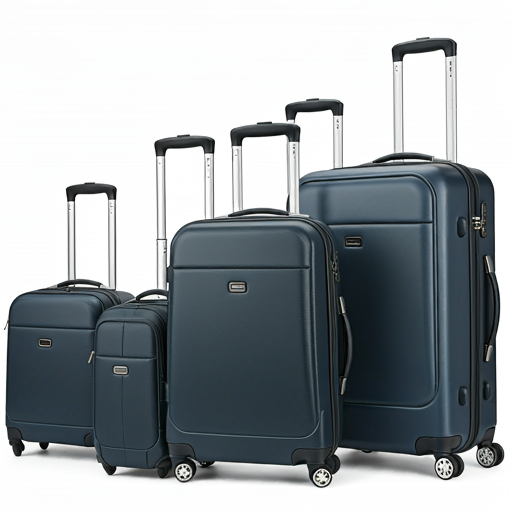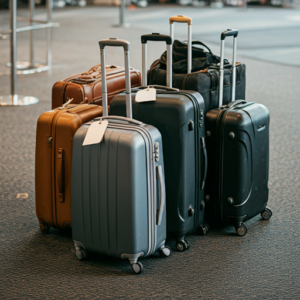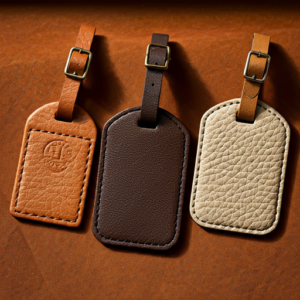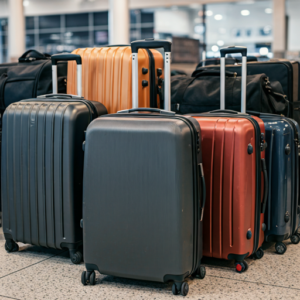Understanding the Importance of Correct Bag Size
Measuring a bag accurately is essential for efficient use of materials, effective packaging, and minimizing waste. A properly sized bag ensures your product fits perfectly, cutting down on excess material and reducing shipping costs. Understanding size and weight restrictions for luggage in most airlines in the context of air travel is crucial to avoid fees and ensure a smooth travel experience. It is also important to measure personal items, such as smaller bags for cameras or laptops, to ensure they fit under the seat and comply with airline regulations. Here’s why choosing shoulder bag of the right size matters:
Too Small: If your bag is undersized, it may tear or fail to close properly, risking damage to the contents and requiring extra materials to secure the product.
Too Large: Oversized bags mean wasted material and higher costs. They require more resources to produce and often incur greater shipping expenses due to bulkier packaging. This excess also contributes to a larger carbon footprint.
Table of Contents
Correctly sized bags help reduce waste and environmental impact. Accurate measurements not only make a difference for the environment but also streamline the supply chain by optimizing storage and handling processes. Additionally, well-fitting bags protect your product, maintaining its integrity and appearance during transit.
Understanding Handbag Measurements
Handbag measurements are crucial in determining the perfect fit for your needs. Understanding the different dimensions of a handbag, including length, height, width/depth, and drop, can help you make an informed purchase decision. The length of a handbag refers to the longest side, typically measured from one end to the other. The height is the vertical distance from the bottom to the top of the handbag. The width/depth is the distance from the front of the bag to the back. The drop, also known as the handle drop, is the length of the handles or straps from the top of the bag to their peak when hung.
Accurate handbag measurements ensure that the bag will fit your belongings comfortably and suit your style preferences. Whether you’re looking for a compact crossbody bag for daily use or an oversized bag for travel, knowing these dimensions will help you select the right bag for your needs.
Types of Bags and Their Bag Dimensions
Different bag and box types come with unique dimensions suited to specific needs, whether for travel, packaging, or storage.
Carry-on Bags: These must adhere to airline regulations with precise dimensions to avoid issues at the airport. Airlines often use linear inches (the total of length, width, and height) to determine compliance with size restrictions. It’s also crucial to measure personal items, such as smaller bags for cameras or laptops, to ensure they fit under the seat and comply with airline regulations.
Check-in Bags: While larger than carry-ons, they still have specific size limits to prevent extra fees.
Plastic Bags: Used for shopping or packaging, these vary in size and shape based on their intended use.
Specialty bags like gusseted bags are designed with an expandable side or bottom gusset, requiring more material to accommodate bulkier items. Gusseted bags offer extra space, making them ideal for carrying some products that need a wider opening or additional room, such as baked goods or large clothing items.
Key dimensions like the flat surface width, diameter (measurement across a laid-flat bag) and measure length (distance from top opening to bottom seam) ensure a bag can accommodate the product’s shape without overextension or tearing.
For boxes or containers, measuring these before selecting a bag size prevents wasted space and unnecessary movement during transit. Accurate measurements of container size can also optimize storage and transportation, saving costs and boosting efficiency.

Measure the Length, Width, and Depth: Lay the bag flat on a surface for accurate readings. Knowing these dimensions helps you pick the right bag for your needs, whether for travel, storage, or shipping.
Luggage Measurement: Stand the luggage upright and retract any handles before measuring from the base to the top. Include retractable handles to ensure your bag fits within airline size restrictions.
Depth Measurement: From back to front, measure depth, especially noting zipper compartments. Bags with multiple sections or expandable features may vary in depth, and an accurate reading helps avoid overstuffing, which can cause damage.
Width Measurement and Linear Dimensions: Measure from one outer edge to the other, then add the three numbers (length, width, depth) to get the linear measurement, especially important for airline guidelines. This total ensures your bag meets requirements and prevents excess fees.
Measuring Bag Dimensions with a Measuring Tape
Measuring bag dimensions is a crucial step in ensuring that you have measured the correct bag size for your needs. To measure a bag, you will need a tape measure or a ruler. Here’s a step-by-step guide on how to measure bag dimensions:
Measure the Width: Start by laying the bag flat on a surface. Measure the width from one side to the other, making sure to include any seams or folds. This measurement is essential for determining the flat width of the bag.
Measure the Length: Next, measure the length of the bag from the top to the bottom, including any handles or straps. This ensures you account for the entire height of the bag, which is crucial for fitting your product properly.
Measure the Gusset: If the bag has a gusset, measure the width of the gusset from one side to the other. Gusseted bags have expandable sides or bottoms, providing extra space for bulkier items.
Measure the Depth: Finally, measure the depth of the bag from the front to the back, including any pockets or compartments. This dimension is particularly important for bags with multiple sections or expandable features.
When measuring bag dimensions, it’s essential to consider the type of bag you are using. For example, if you are using a gusseted bag, you will need to measure the gusset width and length l, to ensure that it fits your handbag or product properly. Accurate measurements help you select the correct bag size, ensuring a perfect fit and optimal functionality.
Measuring Your Bag with a Measuring Tape
To measure your handbag accurately, you’ll need a flexible measuring tape. Start by laying the handbag on a flat surface and measure the longest side of the bag from one end to the other (length). Next, measure the height of the bag from the bottom to the top, ensuring the bag is upright. Then, measure the width or depth of the bag, placing the measuring tape at the bottom (for rigid bags) or in the middle (for softer bags). Finally, measure the drop by holding the top of the bag and letting the handle or strap hang down naturally.
Using a measuring tape ensures precision, and laying the bag on a flat surface helps avoid any distortions in the measurements. This method is particularly useful for bags with unique shapes or multiple compartments, ensuring you get an accurate reading for each dimension.
Choosing the Right Crossbody Bag for Your Needs
Choosing the right bag for your needs can be overwhelming, especially with the numerous options available. Here are some factors to consider when selecting a bag:
Product Size and Shape: Consider the size and shape of your product to determine the correct bag size. A bag that is too small may not fit your product, while a bag that is too large can lead to wasted material and higher costs.
Product Weight: The weight of your product is crucial in determining the correct bag material and thickness. Heavier items require sturdier materials to ensure the bag can hold the weight securely.
Bag Material: Different materials serve different purposes. For instance, plastic bags are versatile and durable, while paper bags are eco-friendly. Choose the material that best suits your product and its requirements.
Bag Style: The style of the bag, such as a flat bag, a gusseted bag, or a stand-up pouch, should align with your product’s needs. Gusseted bags, for example, offer extra space for bulkier items.
Closure Type: The type of closure, such as a zipper, a tie, or a seal, is essential for maintaining the integrity of the bag’s contents. Choose a closure that provides the necessary security and convenience for your product.
When choosing a bag, it’s essential to consider your airline’s specific needs and requirements. For example, if you are packaging food products, you may need a bag with a specific type of closure or material to ensure food safety. By carefully evaluating these factors, you can select the correct bag size and type, ensuring optimal performance and efficiency.
Choosing the Right Bag Style
Choosing the right bag style depends on your personal preferences, lifestyle, and body type. Shoulder bags are ideal for those who want a hands-free option, while crossbody bags are perfect for those who want a more secure and convenient way to carry their belongings. When choosing a bag style, consider the drop length, which can affect the comfort and positioning of the bag on your body. A bag with an adjustable strap can provide a customizable fit, while a bag with a fixed strap may be more suitable for those with a specific body type.
Different bag styles offer various functionalities. For instance, a shoulder handbag is great for everyday use, providing easy access to your items, while a crossbody bag offers added security and is perfect for travel or busy days. Understanding your needs and preferences will help you choose the right style that complements your lifestyle.
Ensuring a Comfortable Fit
Ensuring a comfortable fit is essential when choosing a handbag. A bag that is too large or too small can be uncomfortable to carry and may not fit your needs. To ensure a comfortable fit, consider the following factors: the drop length, which should be approximately equal distance from the top edge of the bag to the shoulder blade; the mid-waist positioning, which should be comfortable and not too tight; and the lower waist positioning, which should be comfortable and not too loose. Additionally, consider the type of bag you need, such as a carry-on bag or a personal item, and choose a bag that meets the size requirements of your airline or personal needs.
A well-fitting bag not only enhances comfort but also ensures that you can carry your belongings efficiently. By paying attention to these details, you can select a bag that fits well, looks great, and serves its purpose effectively.
Measuring for Specific Applications
For specific uses, consider extra space allowances to ensure proper fit:
Pallet Size: Add 1-2 inches to the width, depth, and height to account for minor size discrepancies and ensure a secure fit.
Container Size: Add half the container’s diameter to its length and 5 inches for overhang. This provides enough space for complete coverage and secure sealing.
Box Size: Add 1 inch to width, depth, and height, plus an additional 5 inches to the length for a snug, secure fit. These allowances help accommodate shifting contents and prevent damage during transit.
The first measurement to take is to determine the width, which is crucial for ensuring the bag fits the intended product.
Take into account the type of bag and its specific function. Different bags—like those with gussets or handles—may need unique measurement approaches. The material and thickness of the carry on the bag should also factor into your decision; these affect the bag’s durability and effectiveness for the intended use.
Special Considerations for Plastic Bag
Plastic bags require unique considerations for a perfect fit:
Add an Extra Inch: For a looser fit, particularly helpful for irregularly shaped or sharp-edged items tha might stretch or tear the bag.
Gusseted Bags Need Extra Material: These bags have expandable sides that provide more space, especially suitable for bulkier items, maintaining shape and integrity even when full.
Flat Width and Length: Accurate flat width and length measurements ensure the right bag choice, helping avoid overstuffing or underfitting, which can cause damage. The width (W) is a crucial dimension that affects the fit of items within the bag.
Material and Thickness: The bag’s material and thickness affect its durability. Thicker bags provide more protection, while thinner bags might be suitable for lightweight items, impacting flexibility and resistance to damage.

Tips and Considerations
Always Measure Yourself: Verify the dimensions yourself before traveling or packing. Use a measuring tape to ensure that your luggage meets airline size regulations, as airlines often measure bags that appear oversized.
Check Retailer Measurements: Don’t rely solely on listed dimensions, as they may differ slightly from actual size.
Weigh Bags: Use a digital luggage scale or bathroom scale to check weight limits. Measure luggage effectively by following a step-by-step process: measure the length, width, and depth of your suitcase, and weigh the bag once packed to avoid excess fees and ensure compliance with airline regulations.
Know Each Leg’s Restrictions: For multi-leg journeys, research weight and size restrictions to avoid oversized baggage fees.
Verify Airline Policies: Check current airline guidelines, including dimension limits, to ensure compliance.
Consider Bag Material: Expanding sections and handles affect overall fit, so measure these details as well.
Pack First, Then Measure: Placing all items in the bag before measuring ensures an accurate fit.
International Differences: Be aware of size and weight restrictions that vary by country.
Account for Extra Features: Straps, wheels, and other accessories impact size and weight, so include them in your measurements.
Common Mistakes to Avoid
When measuring bag dimensions or choosing a bag, there are typically several common mistakes to avoid:
Incorrect Measurements: Ensure you take accurate measurements of your product and bag to guarantee a proper fit. Inaccurate measurements can lead to bags that are either too small or too large, causing inefficiencies and potential damage.
Insufficient Material: Choose a bag with sufficient material to hold your product securely. A bag that is too thin or weak may tear or fail to protect the contents adequately.
Incorrect Closure Type: Select a bag with the correct closure type for your product and needs. The wrong closure can compromise the security and functionality of the bag.
Ignoring Product Weight: Consider the weight of your product when choosing a bag. A bag that cannot support the weight of its contents may break, leading to potential loss or damage.
Not Considering Bag Style: The style of the bag should match your product and packaging process. For example, a gusseted bag is ideal for bulkier items, while a flat bag may be suitable for slimmer products.
By avoiding these common mistakes, you can ensure that you have the correct bag size and type for your needs. This helps reduce waste, save money, and improve the overall efficiency of your packaging process. Accurate bag measurements and thoughtful selection are key to achieving the perfect fit and functionality for your products.
Conclusion
Accurately measuring your bag is key for efficient packaging, reducing waste, and ensuring your container is the perfect fit for your product. By following these guidelines, you can select the right bag size to protect your items and enhance presentation during transit.
Proper dimensions prevent overhang or underfitting, maintain product safety, and minimize environmental impact. Always consider the bag type, material, intended use, and any special considerations—such as gussets or expandable sides—when selecting the right fit for any application.













